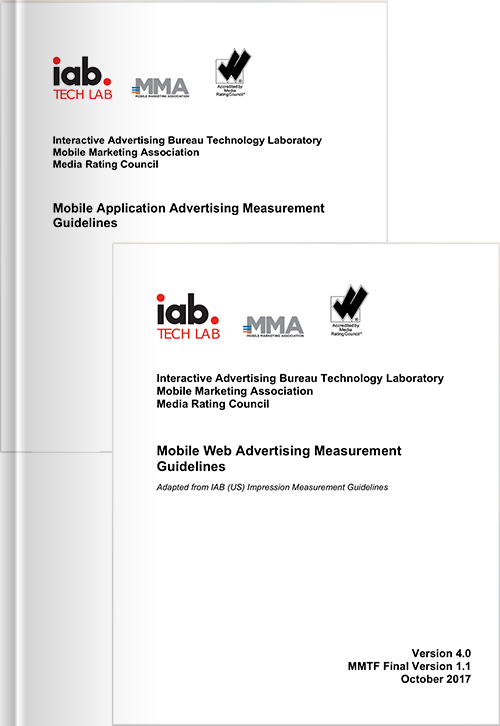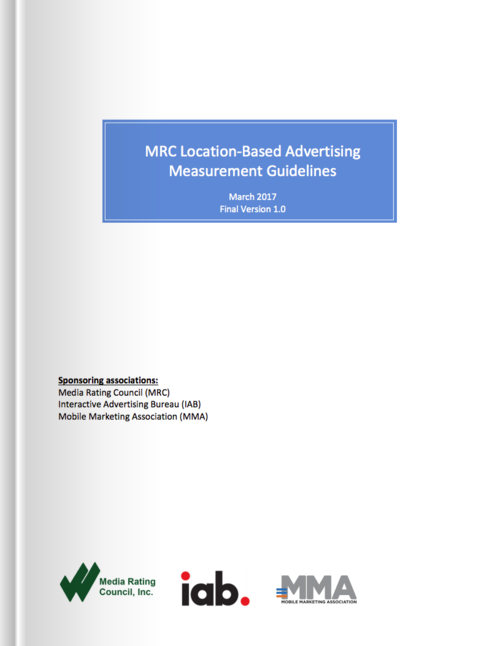Currency Measurement
Currency in the mobile advertising marketplace is the viewable impression, for duration, by a human, in the target audience of choice. As of 31 October 2017 the measurement guidelines supporting this are complete for Mobile Web, Mobile In-App and Location-Based Advertising and the MMA will continue to work with the Media Rating Council (MRC), the IAB and other industry groups to update these as needed.
Current Projects
The Media Rating Council has revisited the previously released Mobile Guidelines (Web and In-App) and updated versions (V1.1) were released on 31 October 2017. Although largely unchanged from V1.0 (April 2017) they are now more in sync with the MRC and IAB initiative to update all measurement guidelines. MRC plans to allow for a one-year grace period after the final releases of these revised guidelines for accredited measurement services to achieve compliance. After this time, the requirements of these will be considered as MRC accreditation criteria. These new guidelines supersede all previous guidance and can be found here and www.mediaratingcouncil.org.
Final Mobile In-App and Mobile Web Advertising Measurement Guidelines
The final guidelines are complete and may be downloaded here.
Download
The MMA encourages all of our members to become familiar with these guidelines, as the changes included will promote improved digital advertising measurement and better align all digital impressions with the viewability standard. The revised guidelines will shift both mobile in-app and mobile web from a “count-on-download” to a “count-on-begin-to-render” ad impression measurement standard. References to “served” impressions have been removed from these updates. The change better aligns measurement with the counting model in place for viewable impressions, as it sets as a foundation those impressions that have rendered and therefore have the potential to be viewable impressions.
To the benefit of brand marketers, these guidelines impose a higher standard on publishers and ad servers that would do away with significant amounts of impressions that were counted against ads that didn’t begin to render. Added benefits of these guidelines include:
-
Better alignment with the standards for viewable impressions, which serve as the baseline metric upon which other KPIs can be built, such as engagement and effectiveness.
-
Addresses the critical distinctions between in-app and web environments, yet offers a comprehensive and compatible approach to counting properly in each situation.
-
The value of transparency and the importance of brands pushing for compliance by all sellers, which will serve to raise the quality level of mobile advertising measurement, disclosures and reporting.
For our members selling mobile advertising, whether in-app or web-based, we strongly encourage you to be conversant and compliant with these guidelines. Doing so will only increase trust in the entire mobile advertising eco-system and will also bring distinction and differentiation to you in the eyes of the brands and agency buyers.
These Guidelines are intended to establish and document good practices of measurement; improve practices and disclosures used by practitioners; and also provide education on the distinct differences with in-app versus web environments. This document also establishes a recommendation for auditing counting methods and supporting processes, whereby the practices and disclosures of ad selling organizations can be voluntarily validated by third parties.
Location-Based Advertising Measurement Guidelines
The Location-Based Advertising Measurement Guidelines are now complete.
Download
The Media Rating Council, at the behest of the MMA, and in collaboration with the IAB, has issued the final Location-Based Advertising Measurement Guidelines. These Guidelines are intended to establish and document good practices of measurement; improve practices and disclosures used by practitioners; and also provide education to users of location-based measurement data from all segments of the Industry. Specifically, these guidelines provide marketers with further clarity on what they should expect from their location data providers, how to align metrics to their marketing objectives and better leverage mobile’s unique ability to drive business impact. This document also establishes a recommendation and a benchmark for audit processes whereby the practices and disclosures of location-based measurement organizations can be voluntarily validated by third parties.


